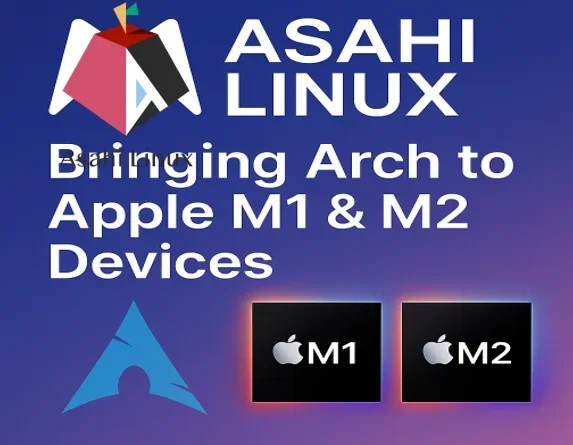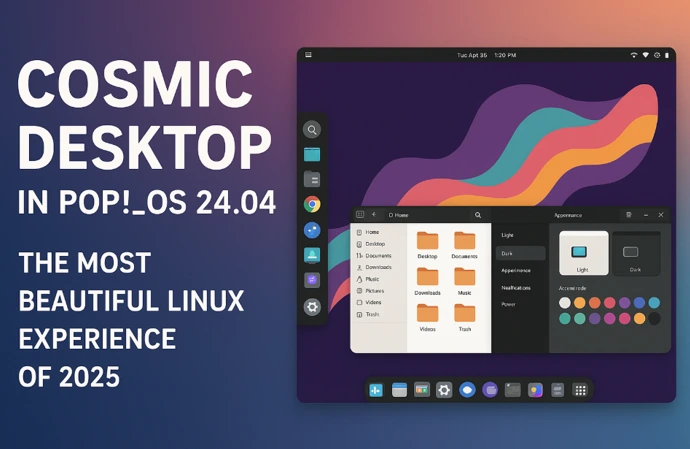
Asahi Linux: Bringing Arch to Apple M1 & M2 Devices
Introduction: The Dawn of Linux on Apple Silicon
When Apple unveiled its transition from Intel processors to custom ARM-based silicon in 2020, it marked a pivotal moment in computing history. The M1 chip, followed by the M2 series, delivered remarkable performance and energy efficiency that quickly set new standards in the industry. However, these advancements came with a significant drawback for Linux enthusiasts and open-source advocates: Apple’s tightly controlled ecosystem meant these powerful machines were initially locked to macOS.
This is where Asahi Linux enters the story. Named after the Japanese word for “morning sun” (朝日), this ambitious community-driven project emerged with a clear mission: to bring the freedom of Linux to Apple Silicon devices. Led by Hector Martin (known online as “marcan”), the project represents one of the most significant reverse-engineering efforts in recent computing history, aiming to create a polished Linux experience on hardware that wasn’t designed to support it.
In this comprehensive guide, we’ll explore how Asahi Linux: Bringing Arch to Apple M1 & M2 Devices, the current state of the project, and what users can expect when venturing into this cutting-edge territory.
The Genesis of Asahi Linux
From Announcement to Reality
In late 2020, as the first M1 Macs were reaching consumers, Hector Martin announced a Patreon-funded effort to port Linux to these new machines. The project quickly gained traction, with many Linux enthusiasts excited about the possibility of running their preferred operating system on Apple’s new hardware.
Martin wasn’t a newcomer to such challenges. With an impressive track record of porting Linux to closed platforms—including the PlayStation 4—he brought valuable experience to what would prove to be an extraordinarily complex undertaking. The project officially launched in early 2021, and by March 2022, the first alpha release of Asahi Linux became available to the public.
Why Arch Linux?
Among the many Linux distributions available, the Asahi team chose Arch Linux as their foundation. This decision wasn’t arbitrary—Arch’s rolling release model, minimalist approach, and comprehensive documentation make it an ideal base for a project that requires constant updates as new hardware support is developed.
Arch Linux is known for:
- Bleeding-edge software: Essential for a project where driver development is ongoing
- Flexibility: The minimalist base allows the Asahi team to build precisely what’s needed
- Strong community: The Arch wiki and community support provide valuable resources
- Package management: The powerful pacman package manager and access to the AUR (Arch User Repository)
The Asahi Linux installer provides users with two main options: the full Asahi Linux desktop experience based on Arch with a KDE Plasma desktop environment, or a minimal installation that serves as a foundation for users who prefer to customize their setup from the ground up.
Technical Challenges: Reverse Engineering Apple Silicon
The M1/M2 Architecture
Apple’s M1 and M2 chips represent significant departures from traditional computer architecture. As Systems-on-Chip (SoCs), they integrate the CPU, GPU, Neural Engine, I/O controllers, and more onto a single package. This integration delivers impressive performance and power efficiency but creates numerous challenges for operating system development.
Unlike many ARM-based systems, Apple’s chips don’t fully implement industry-standard interfaces. Instead, they use custom hardware blocks and proprietary protocols, requiring extensive reverse engineering to understand and implement compatible drivers.
The Reverse Engineering Process
The Asahi Linux team faces several major technical hurdles:
- Limited documentation: Apple doesn’t publish detailed technical specifications for its hardware
- Custom boot architecture: Apple Silicon uses a complex, secure boot process that’s entirely different from traditional BIOS/UEFI systems
- Proprietary GPU: The integrated graphics processor requires entirely new driver development
- Custom hardware controllers: From NVMe to USB to display outputs, almost every component uses Apple-specific implementations
Despite these challenges, the team has made remarkable progress through careful reverse engineering. This process typically involves:
- Studying macOS drivers and firmware
- Analyzing hardware behavior through extensive testing
- Developing open-source replacements for proprietary components
- Creating entirely new drivers for unique hardware
Security Considerations
Apple Silicon incorporates sophisticated security features, including:
- Secure Enclave Processor (SEP): A dedicated security subsystem
- Secure boot chain: Cryptographically verified boot process
- Memory protection: Hardware-enforced security boundaries
The Asahi Linux project maintains these security features while providing an open-source alternative operating system. Unlike some reverse-engineering projects that might compromise security to enable functionality, Asahi Linux works alongside Apple’s security architecture, using the m1n1 bootloader to bridge between Apple’s closed boot process and the open Linux kernel.
Current State of Support (As of May 2025)
Hardware Support Matrix
Support for Apple Silicon hardware continues to evolve rapidly. Here’s the current status for key components:
| Component | Support Level | Notes |
|---|---|---|
| CPU | Full support | All cores (performance and efficiency) are functional |
| RAM | Full support | Full memory addressing |
| USB | Full support | USB 3 and USB 2 work on all ports |
| Wi-Fi | Good | Works well but with some power management limitations |
| Bluetooth | Good | Core functionality works with some features under development |
| Display | Good | Internal displays work at native resolution |
| GPU | Improving | Basic acceleration with Mesa drivers, performance improving |
| Audio | Good | Speaker and headphone support with ongoing improvements |
| Webcam | Basic | Functional but with quality limitations |
| Touch Bar | Basic | Works as a display with basic input |
| Keyboard/Trackpad | Good | Full functionality including gestures |
| Battery/Power Management | Improving | Basic support with ongoing efficiency improvements |
| External Displays | Partial | Works on most M1 devices, limited on M2 |
| Thunderbolt | Partial | Basic USB-C functionality, Thunderbolt support improving |
Supported Devices
The project has expanded support to include a wide range of Apple Silicon machines:
- MacBook Air (M1, M2)
- MacBook Pro (M1, M2, M2 Pro, M2 Max)
- Mac mini (M1, M2)
- iMac (M1, M2)
- Mac Studio (M1 Max, M2 Max)
- Mac Pro (M2 Ultra)
The latest development efforts have particularly focused on improving support for the M2 series chips, including advanced features like ProMotion displays, additional GPU cores, and enhanced neural engines.
Installation Process: Getting Started with Asahi Linux
Prerequisites
Before installing Asahi Linux, users should ensure they have:
- A supported Apple Silicon Mac (M1 or M2 series)
- macOS Monterey (12.0) or later installed
- At least 53GB of free storage space for a full installation
- A recent backup of important data
- Stable internet connection for downloading packages
Installation Steps
The installation process has been streamlined significantly since the project’s inception:
- Run the installer: From macOS, download and run the Asahi Linux installer script
- Repartitioning: The installer will resize your macOS partition to create space
- Component installation: Core components, including the m1n1 bootloader, are installed
- System configuration: Basic system settings are configured
- Desktop environment setup: For full installations, KDE Plasma and essential applications are installed
- Reboot and enjoy: After installation, you can choose between macOS and Asahi Linux at boot time
The installer uses a user-friendly, text-based interface that guides users through these steps with clear explanations and options. Importantly, the installation is non-destructive—your macOS installation remains fully functional, and you can dual-boot between operating systems.
Post-Installation Configuration
After installation, several additional steps are recommended:
- System updates: Run sudo pacman -Syu to ensure all packages are current
- User software installation: Install additional software using pacman or the AUR
- Desktop customization: Configure KDE Plasma or install alternative desktop environments
- Power management tuning: Adjust settings for optimal battery life
- Hardware testing: Verify all components are functioning correctly
The User Experience: Daily Life with Asahi Linux
Performance Considerations
The performance of Asahi Linux on Apple Silicon presents an interesting contrast to macOS:
- CPU performance: Linux generally utilizes the CPU cores efficiently, with performance close to macOS in CPU-bound tasks
- GPU performance: This remains the largest gap, with the Linux GPU drivers still maturing compared to Apple’s highly optimized implementations
- Battery life: While improving with each release, battery life under Linux typically ranges from 60-80% of what the same hardware achieves under macOS
- Thermal management: The system runs slightly warmer under Linux, though thermal throttling functions properly to prevent overheating
Real-world benchmarks show that for development work, text processing, and general productivity, the experience is quite comparable to macOS. However, graphics-intensive applications and games still perform significantly better under macOS due to the advanced state of Apple’s GPU drivers.
Software Ecosystem
One of the advantages of running Arch Linux is access to the vast Linux software ecosystem:
- Development tools: Complete access to compilers, interpreters, and IDEs
- Creative applications: GIMP, Inkscape, Kdenlive, and other creative tools
- Productivity software: LibreOffice, Firefox, Thunderbird, and countless others
- Gaming: Access to native Linux games and compatibility layers like Steam Proton
The Arch User Repository (AUR) further expands software availability, though users should note that not all software is optimized for ARM architecture. However, the growing popularity of ARM servers and development machines means that ARM compatibility is rapidly improving across the Linux ecosystem.
Community and Support
The Asahi Linux community has grown into a vibrant ecosystem:
- Official documentation: Comprehensive guides on the Asahi Linux website
- Discord server: Active community with dedicated support channels
- GitHub repositories: Open development with opportunities for contribution
- Wiki: User-contributed knowledge and troubleshooting
- Matrix chat: Real-time community support
This community-driven approach means that solutions to common problems are typically well-documented, and users can often get real-time assistance with more complex issues.
Development Roadmap: Looking to the Future
Current Development Priorities
As of May 2025, the Asahi Linux team is focusing on several key areas:
- GPU driver maturity: Improving performance and compatibility of the open-source GPU drivers
- Power management: Enhancing battery life through more efficient resource management
- Hardware compatibility: Expanding support for newer M2 variants and peripherals
- Audio subsystem: Refining speaker and microphone quality
- External display support: Improving multi-monitor capabilities
- Thunderbolt functionality: Enhancing support for high-speed peripherals
The project maintains a transparent development roadmap on GitHub, with regular progress updates shared through the project’s blog and social media channels.
The Upstream First Approach
A core philosophy of the Asahi Linux project is to integrate changes into the mainline Linux kernel whenever possible, rather than maintaining a separate fork. This “upstream first” approach means that improvements developed for Asahi Linux benefit the broader Linux ecosystem and ensure long-term sustainability.
Many of the drivers and subsystems developed for Asahi Linux have already been incorporated into the mainline kernel, making Apple Silicon support a standard feature of recent Linux distributions.
Comparing with Alternatives: Other Operating Systems on Apple Silicon
Virtualization Options
For users who prefer to keep macOS as their primary operating system, virtualization offers an alternative approach:
- UTM: Uses QEMU to provide full virtualization of Linux on macOS
- Parallels Desktop: Commercial solution with optimized ARM Linux support
- VMware Fusion: Enterprise-focused virtualization solution
These virtualization solutions offer convenience and stability but with performance penalties compared to native booting. They also don’t provide the same level of hardware access that Asahi Linux offers.
Other Native Alternatives
While Asahi Linux is the most mature project for running Linux natively on Apple Silicon, other options exist:
- Fedora Asahi Remix: An official Fedora spin leveraging Asahi Linux’s work
- Ubuntu: Experimental builds based on Asahi drivers
- NixOS: Community-maintained configurations
These alternatives use the core hardware support developed by the Asahi Linux team but package it with different Linux distributions to suit various user preferences.
Practical Applications: Who Should Use Asahi Linux?
Ideal Use Cases
Asahi Linux is particularly well-suited for:
- Developers: Especially those working on cross-platform or Linux-focused projects
- Open-source enthusiasts: Users who value software freedom and customization
- System administrators: Those wanting to test Linux server configurations on powerful hardware
- Computer science students: Learning operating system concepts on modern hardware
- Privacy-focused users: Those seeking more control over their computing environment
Limitations to Consider
Despite its impressive progress, potential users should be aware of some limitations:
- Professional creative work: The GPU drivers aren’t yet optimized for professional creative applications
- Gaming: Limited 3D performance compared to macOS
- Machine learning: Neural Engine support is still experimental
- Enterprise environments: Limited enterprise management tools
- Specialized hardware: Some niche peripherals may lack driver support
Conclusion: The Growing Ecosystem of Open Hardware Support
Asahi Linux represents more than just an alternative operating system for Apple hardware—it symbolizes the open-source community’s resilience and technical prowess in the face of increasingly closed hardware ecosystems. By creating open drivers and documentation for Apple Silicon, the project preserves user freedom and choice on some of the most advanced consumer hardware available.
As the project matures, it continues to narrow the gap between the proprietary macOS experience and the open Linux alternative. For users who value both cutting-edge hardware and software freedom, Asahi Linux offers an increasingly viable path to enjoying the best of both worlds.
Whether you’re a developer seeking a powerful Linux development machine, an enthusiast curious about the latest technology, or simply someone who wants more control over their computing environment, Asahi Linux demonstrates that even the most closed systems can be opened through community effort, technical expertise, and dedication to the principles of open software.
The morning sun of Linux on Apple Silicon continues to rise, illuminating new possibilities for this powerful hardware platform.
Disclaimer
This article is provided for informational purposes only. While we strive to ensure the accuracy and currency of all information presented, the rapidly evolving nature of the Asahi Linux project means that some details may change by the time you read this.
Installing alternative operating systems on your devices carries inherent risks, including potential data loss, hardware damage, or security vulnerabilities. The information provided in this article should not be considered a substitute for official documentation or professional advice.
Before installing Asahi Linux on your Apple Silicon device:
- Ensure you have complete backups of all important data
- Understand that you may void your warranty by installing third-party operating systems
- Recognize that not all features of your hardware may work as expected
- Be prepared to troubleshoot issues that may arise
The author and publisher of this article are not affiliated with Apple Inc. or the official Asahi Linux project unless explicitly stated. Apple, Mac, MacBook, M1, and M2 are trademarks of Apple Inc. Arch Linux is a trademark of the Arch Linux project. All other trademarks mentioned belong to their respective owners.
Resources and Further Reading
Frequently Asked Questions
Will installing Asahi Linux void my Apple warranty?
Not necessarily! While Apple doesn’t officially support running non-macOS operating systems, the Asahi Linux installation process doesn’t make any permanent modifications to your hardware. The installer partitions your drive without altering Apple’s firmware or security systems. According to user reports, Apple Support has helped with hardware issues on machines running Asahi Linux, though they might ask you to reinstall macOS before providing software support. That said, I’d recommend reinstalling macOS if you need to take your Mac in for service, just to avoid any potential complications.
Can I run my favorite macOS apps on Asahi Linux?
Unfortunately, no—macOS applications won’t run natively on Asahi Linux. You’ll need to find Linux alternatives for your workflow. The good news is that the Linux ecosystem is mature, with excellent options for most tasks. For development, you’ll find the environment possibly even better than macOS with native access to Linux tools. For creative work, apps like GIMP, Krita, and Kdenlive offer powerful alternatives to Adobe software, though there’s definitely an adjustment period. Wine can run some Windows applications, but performance varies widely, especially on ARM architecture.
Is it difficult to switch back to macOS if I don’t like Asahi Linux?
Not at all! One of the best things about Asahi Linux is how non-destructive the installation is. When you install Asahi, it sets up a dual-boot system where you can choose between macOS and Linux at startup by holding the power button. If you decide Asahi isn’t for you, simply boot back into macOS, open Disk Utility, and delete the Asahi Linux partition to reclaim your space. You can even remove the boot loader if you want to return completely to the stock configuration. I’ve gone back and forth several times without issues.
I’m completely new to Linux. Is Asahi Linux right for me?
I’d say it depends on your appetite for tinkering and problem-solving. Asahi Linux, while increasingly polished, still requires comfort with the command line and a willingness to troubleshoot occasional issues. If you’ve never used Linux before, you might face a double learning curve—both the Linux ecosystem and the specific quirks of running Linux on Apple hardware. That said, the documentation is excellent, and the community is incredibly helpful. If you’re curious and patient, it can be a fantastic way to explore Linux on your existing hardware without the commitment of buying a separate machine. Just be prepared for occasional frustrations and learning opportunities along the way!
Also Read
The Best Linux Distributions for Your Old MacBook or iMac: Breathe New Life into Your Apple Hardware




